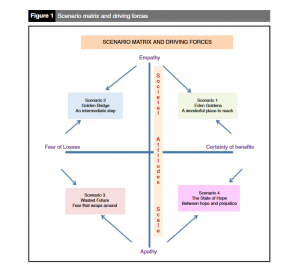Purpose – The purpose of this paper is to contribute to the analysis and grasp of accessible tourism, from its present into a medium-term future. It provides a socio-anthropological approach.
Design/methodology/approach – This paper uses the scenarios-planning analysis framework proposing four scenarios arising from the interaction of aforementioned driving forces. The author also use a trilemma to both form and evaluate scenarios. The criteria for the trilemma were (stakeholders, cooperation and prejudice).
Findings – The strength of combining a new set of driving forces, namely, empathy, apathy, certainty in economic profits and fear of economic losses, which would enable to draw four plausible scenarios into the future of accessible tourism within a scenarios-planning framework. The significance is to provide “food for thought” to address the future through a range of different concepts.
Research limitations/implications – The main limitation is the difficulty to obtain honest answers about why the lack of development of accessible tourism.
Practical implications – Participant observation on both groups and individuals in vacation atmosphere. Also, in-depth interviews to different stakeholder representatives.
Social implications – To try to explain to the stakeholders their wasted economic benefits and, at the same time, the opportunity of getting social prestige.
Originality/value – The main value is about considering the interplay of social concepts as empathy, apathy, “aesthetic prejudice” and fear of losses or faith in profits.
Cruces, R., (2015): “Removing ‘invisible’ barriers: opening paths towards the future of accessible tourism”. Journal of Tourism Futures, Vol I, Iss 3, pp. 269-284

